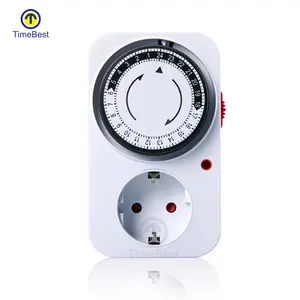(69494 products available)





























































































































































































A light timer is an automated device that manages the activation and deactivation of lighting systems, playing a pivotal role in energy savings, enhancing security, and providing user convenience. Light timers boast adaptability, finding utility across a spectrum of environments, from homes to business premises, orchestrating illumination according to preset schedules.
On Chovm.com, shoppers can find a plethora of light timers, each with distinct features. The simplest are mechanical timers, equipped with a manual dial for setting operational intervals. Digital timers deliver enhanced accuracy and can handle numerous on/off cycles. Programmable timers offer the flexibility to define unique daily schedules, suiting the dynamic demands of business environments. Smart timers, the zenith of convenience and personalization, mesh with home automation systems and can be managed from afar.
A typical light timer comprises a power source, an interface for user control, a timing mechanism, and a component for switching. Power may come directly from a building's electrical grid or from batteries. Interfaces range from simple dials and buttons to sophisticated touchscreens on smart devices. Timing is tracked through mechanical or digital clocks, while relays or semiconductor switches trigger the lights at designated times. Smart timers may also include modules for Wi-Fi or Bluetooth to facilitate remote control.
Manufacturers of light timers select robust materials such as ABS plastic for casings, prized for its sturdiness and insulating prowess. Metals like aluminum serve in heat-dissipating roles within the timer's innards. PC materials are favored for their impact resistance and transparency, crucial for clear covers or displays. These materials are chosen for their durability and their capacity to shield electronic internals from environmental elements.
In the commercial sphere, light timers prove indispensable. Retailers employ them to accentuate displays and curtail energy expenses post-business hours. In the agricultural sector, they control grow lights, directly influencing harvests. Hospitality venues deploy them to foster inviting atmospheres while managing power consumption adeptly. The use of timer lights outdoor in communal areas bolsters security and supports smart urban development initiatives, showcasing the device's contribution to commercial efficacy and value creation.
The quintessential role of a light timer is to automate lighting operations. They adeptly execute tasks such as activating lights at twilight and deactivating them at dawn, aligning light usage with business hours, or mimicking occupancy through random lighting patterns for security enhancement. Smart timers further boast the capability to modulate light intensity based on ambient conditions or to synchronize with motion detectors, providing illumination on an as-needed basis.
Light timers are endowed with an array of features that bolster their practicality and operational efficiency. For instance, backup batteries preserve programmed schedules during power disruptions. Smart timers distinguish themselves with functionalities like voice commands via digital assistants, monitoring of usage, and reports on energy consumption, offering users superior management and insights into their energy practices.
The advantages of employing light timers are multifaceted. They ensure energy is expended judiciously, leading to cost reductions for businesses. They also simulate occupancy, deterring unauthorized entry. For homeowners, they eliminate the need for manual light toggling, and for those environmentally attuned, they serve as an instrument for carbon footprint minimization.
To effectively deploy a light timer, one must first establish a lighting schedule. For mechanical models, this entails aligning the dial with the current time and selecting the desired intervals. Digital and smart timers necessitate programming via an interface or application. It's crucial to position the timer in a spot where it can function unhindered and is readily accessible for any adjustments.
Selecting an apt light timer requires an evaluation of your specific environmental needs. Consider the cumulative wattage of the lights to be managed, the intricacy of the desired schedule, and the preference for remote access. For outdoor applications, verify that the timer possesses a suitable IP rating for weather endurance. Compatibility with existing smart home systems is a prerequisite for tech enthusiasts.
Cleaning a light timer entails dusting the apparatus with a dry or minimally moist cloth to avoid accumulation of grime. Refrain from using abrasive chemicals that could harm the device. Maintenance might involve verifying battery levels for units with auxiliary power and performing software updates for intelligent timers. Periodic testing is advised to ensure the timer's reliability and continued service.
The installation process for a light timer varies by type. Plug-in models are straightforward: simply connect the timer to an outlet and then the light to the timer. Hardwired versions should be installed by certified electricians to guarantee safety and regulatory adherence. Smart timers may necessitate additional steps for network integration and app configuration.
Chovm.com presents an extensive selection of light timers, from uncomplicated mechanical devices to advanced digital and smart timers that seamlessly integrate with home automation systems. Catering to both residential and commercial needs, the platform offers a diverse array of light timers to suit various preferences and requirements.
Businesses can weave light timers into their operational fabric by managing illumination in workspaces, storefronts, and exterior settings. This strategy not only slashes energy consumption but also fortifies security and augments ambiance. For example, a timer switch for lights can be programmed to effectively spotlight signage or landscape elements.
Indeed, Chovm.com offers customizable solutions for light timers. Companies can solicit customized support for particular functionalities, design aesthetics, and technical specifications to fulfill their distinctive needs. This encompasses software customization and OEM services to tailor the timers to precise business applications.